15-5 The universe was a rapidly expanding, hot, opaque plasma during its first 300,000 years and has slowly cooled
 Go to Video 15-3
Go to Video 15-3
Everything in the universe falls into one of two categories—energy or matter. One form of energy is radiation, that is, photons. There are many photons of starlight traveling across space, but the vast majority of photons in the universe belong to the cosmic microwave background. The matter in the universe is contained in such luminous objects as stars, planets, and galaxies, as well as in nonluminous dark matter. A natural question to ask is this: Which plays a more important role in the universe, radiation or matter? As we will see, the answer to this question is different for the early universe from the answer for our universe today.
Radiation and Matter in the Universe
Most of outer space is seemingly empty. Although the average density of matter in the universe is tiny by Earth standards, it turns out that it is thousands of times larger than the mass density of radiation in the universe. However, this was not always the case. Matter prevails over radiation today only because the energy now carried by microwave photons is so small. Nevertheless, the number of photons in the microwave background is astounding. Today, there are 410 million (4.1 × 108) photons in every cubic meter of space. In other words, the photons in space outnumber atoms by roughly a billion (109) to one. In terms of total number of particles, the universe thus consists almost entirely of microwave photons. This radiation field no longer has much “clout,” however, because its photons have been redshifted to long wavelengths and low energies after 13.7 billion years of being stretched by the expansion of the universe.
Light remaining from the formation of the universe is seen everywhere in the form of microwave photons.
In contrast, think back toward the Big Bang. The universe becomes increasingly compressed, and thus the density of matter increases as we go back in time. The photons in the background radiation also become more crowded together as we go back in time. But, in addition, the photons become less redshifted and thus have shorter wavelengths and higher energy than they do today. Because of this added energy, the mass density of radiation increases more quickly as we go back in time than does the average density of matter. In fact, as Figure 15-11 shows, there was a time in the ancient past when these two quantities were equal. Before this time, radiation held sway over matter. This transition from a radiation-dominated universe to a matter-dominated universe occurred about 70,000 years after the Big Bang.
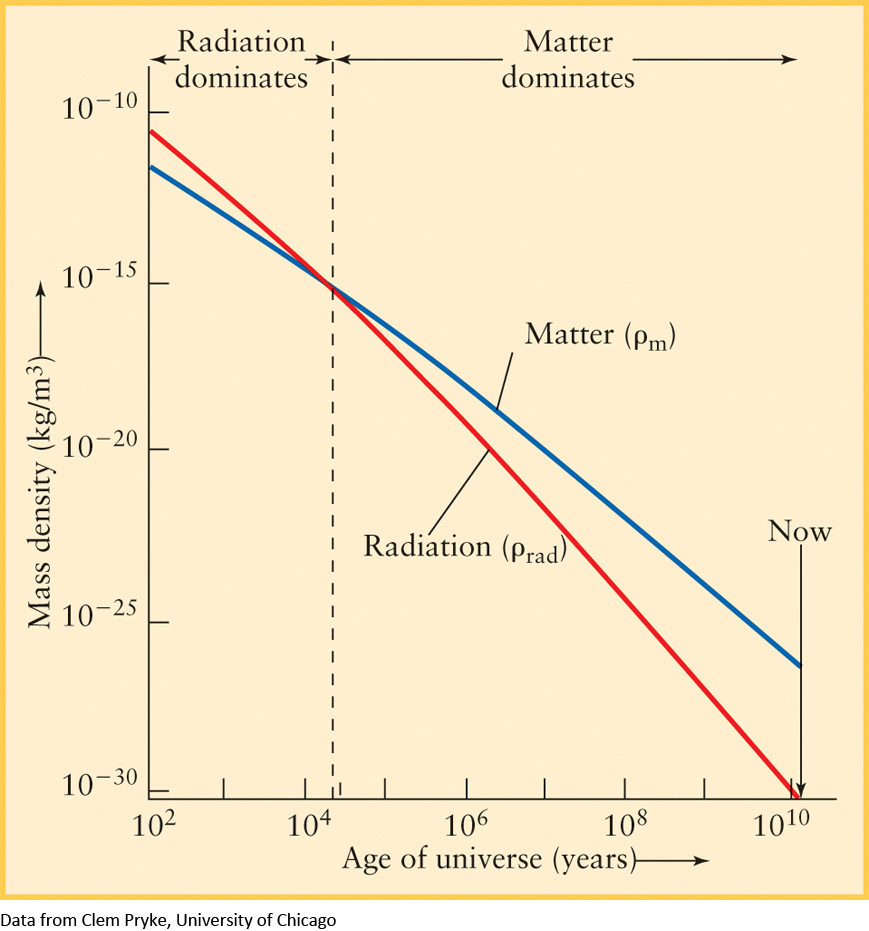
Question
ConceptCheck 15-8: At the time Earth formed, was the universe dominated by energy or by matter?
When the First Atoms Formed
The nature of the universe changed again in a fundamental way about 380,000 years after the Big Bang, when the temperature of the radiation background was about 1100 × 2.725 K = 3000 K. To see the significance of this moment in cosmic history, recall that hydrogen is by far the most abundant element in the universe—hydrogen atoms outnumber helium atoms by about 12 to 1. A hydrogen atom consists of a single proton orbited by a single electron, and it takes relatively little energy to knock the proton and electron apart. In fact, ultraviolet radiation warmer than about 3000 K easily ionizes hydrogen. Thus, hydrogen atoms could not survive in the universe that existed in the first 380,000 years after the Big Bang, when the background photons had energies great enough to prevent electrons and protons from binding to form hydrogen atoms (Figure 15-12). Only since then have the energies of these photons been low enough to permit hydrogen atoms to exist (Figure 15-12b).
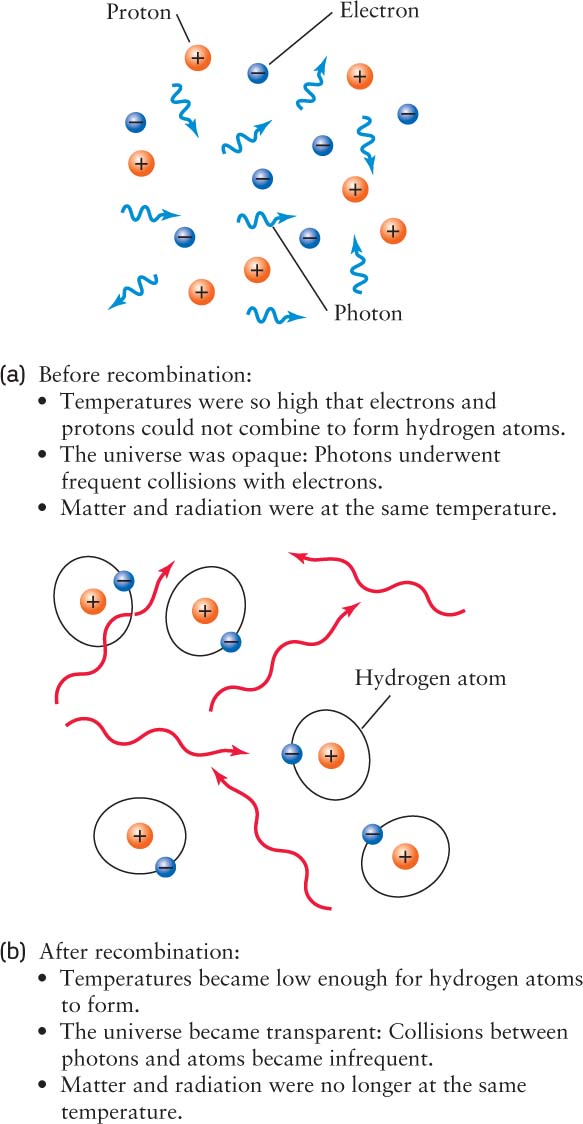
370
The epoch when atoms first formed at t = 380,000 years is called the era of recombination. This refers to electrons “recombining” to form atoms. (The name is a bit misleading, because the electrons and protons had never before combined into atoms.)
Prior to t = 380,000 years, the universe was completely filled with a shimmering expanse of high-energy photons colliding vigorously with protons and electrons. This state of matter, called a plasma, is opaque, just like the glowing gases inside a discharge tube (like a neon advertising sign). The surface and interior of the Sun are also a hot, glowing, opaque plasma.
After t = 380,000 years, the photons no longer had enough energy to keep the protons and electrons apart. As soon as the temperature of the field fell below about 3000 K, protons and electrons began combining to form hydrogen atoms. These atoms do not absorb low-energy photons, and so space became transparent! All the photons that heretofore had been vigorously colliding with charged particles could now stream unimpeded across space. Today, these same photons constitute the microwave background.
Before recombination, matter and the energy field had the same temperature, because photons, electrons, and protons were all in continuous interaction with one another. After recombination, photons and atoms hardly interacted at all, and thus the temperature of matter in the universe was no longer the same as the temperature. Thus, T = 2.725 K is the temperature of the present-day background radiation field, not the temperature of the matter in the universe. Note that while the temperature of the background is very uniform, the temperature of matter in the universe is anything but: It ranges from hundreds of millions of kelvins in the interiors of giant stars to a few tens of kelvins in the interstellar medium.
ANALOGY
A good analogy is the behavior of a glass of cold water. If you hold the glass in your hand, the water will get warmer and your hand will get colder until both the water and your hand are at the same temperature. But if you set the glass down and do not touch it, so that the glass and your hand do not interact, their temperatures are decoupled: The water will stay cold and your hand will stay warm for much longer.
Because the universe was opaque prior to t = 380,000 years, we cannot see any further into the past than the era of recombination. In particular, we cannot see back to the era when the universe was radiation-dominated. The microwave background contains the most ancient photons we will ever be able to observe.
Question
ConceptCheck 15-9: If the universe had cooled more slowly, would the first atoms have appeared more quickly or more slowly?
Nonuniformities in the Early Universe and the Origin of Galaxies
Careful analysis of COBE data showed that the microwave photons in the cosmic background are not completely isotropic. Even when the effects of Earth’s motion are accounted for, there remain variations in the temperature of this energy field of about 100 μK (100 microkelvins, or 10−4 K) above or below the average 2.725 K temperature. These tiny temperature variations indicate that the matter and energy in the universe were not totally uniform at the moment of recombination. Regions that were slightly denser than average were also slightly cooler than average; less dense regions were slightly warmer. When energy decoupled from matter at the time of recombination, the radiation preserved a record of these variations in temperature and density.
371
Astronomers place great importance on studying temperature variations in the cosmic background. The reason is that concentrations of mass in our present-day universe, such as superclusters of galaxies, are thought to have formed from the denser regions in the early universe. Within these immense concentrations formed the galaxies, stars, and planets. Thus, by studying these nonuniformities, we are really studying our origins.
Unfortunately, the detectors on board COBE had a relatively coarse angular resolution of 7° and thus could not give a detailed picture of these temperature variations. In 1998 two balloon-borne experiments, BOOMERANG and MAXIMA, carried new, high-resolution telescopes aloft to study the cosmic background radiation with unprecedented precision. The best all-sky coverage of the background radiation has come from the state-of-the-art detectors on board the Wilkinson Microwave Anisotropy Probe (WMAP). Shown in Figure 15-13, the spacecraft is named for the late David Wilkinson of Princeton University, who was a pioneer in studies of the cosmic background radiation. This figure also shows a map of the sky based on data taken by the WMAP detectors. This map shows us the state of the universe when it was less than 0.003% of its present age.
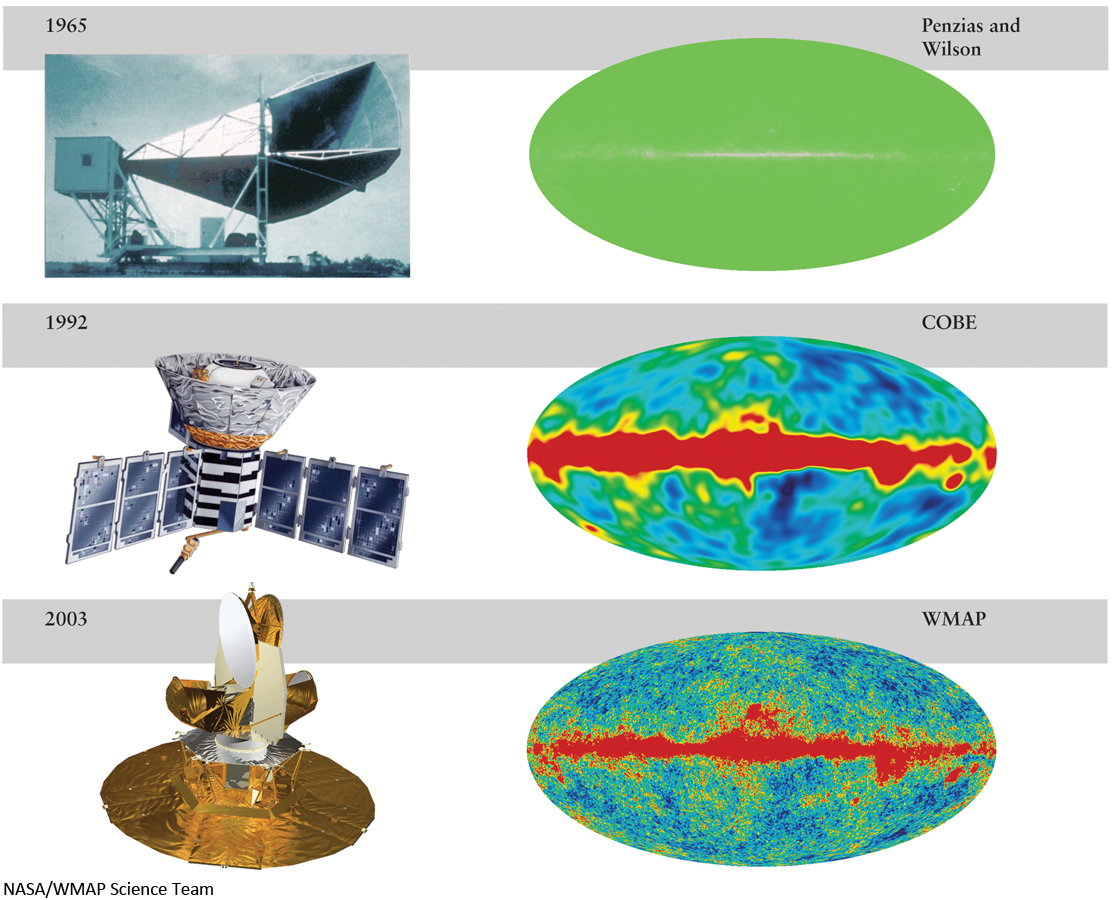
Question
ConceptCheck 15-10: What does the WMAP data show and how does it compare to earlier observations?
The Newborn Universe Underwent a Brief Period of Vigorous Expansion
With the discovery of the cosmic microwave background, astronomers had direct evidence to support the expansion observations made by Hubble that the universe began with a hot Big Bang. In the early 1980s, working independently, Alexei Starobinsky at the L. D. Landau Institute of Theoretical Physics in Moscow and Alan Guth at Stanford University suggested that the universe might have experienced a brief period of extremely rapid expansion just after the Big Bang started. Their theories provided a way of getting around some problems in earlier thinking about how exactly the Big Bang occurred. During this inflationary epoch, the universe expanded outward in all directions by a factor of about 1050. This epoch of dramatic expansion may have lasted only about 10−32 second (Figure 15-14), but would have been enough to account for the observations we are making today.
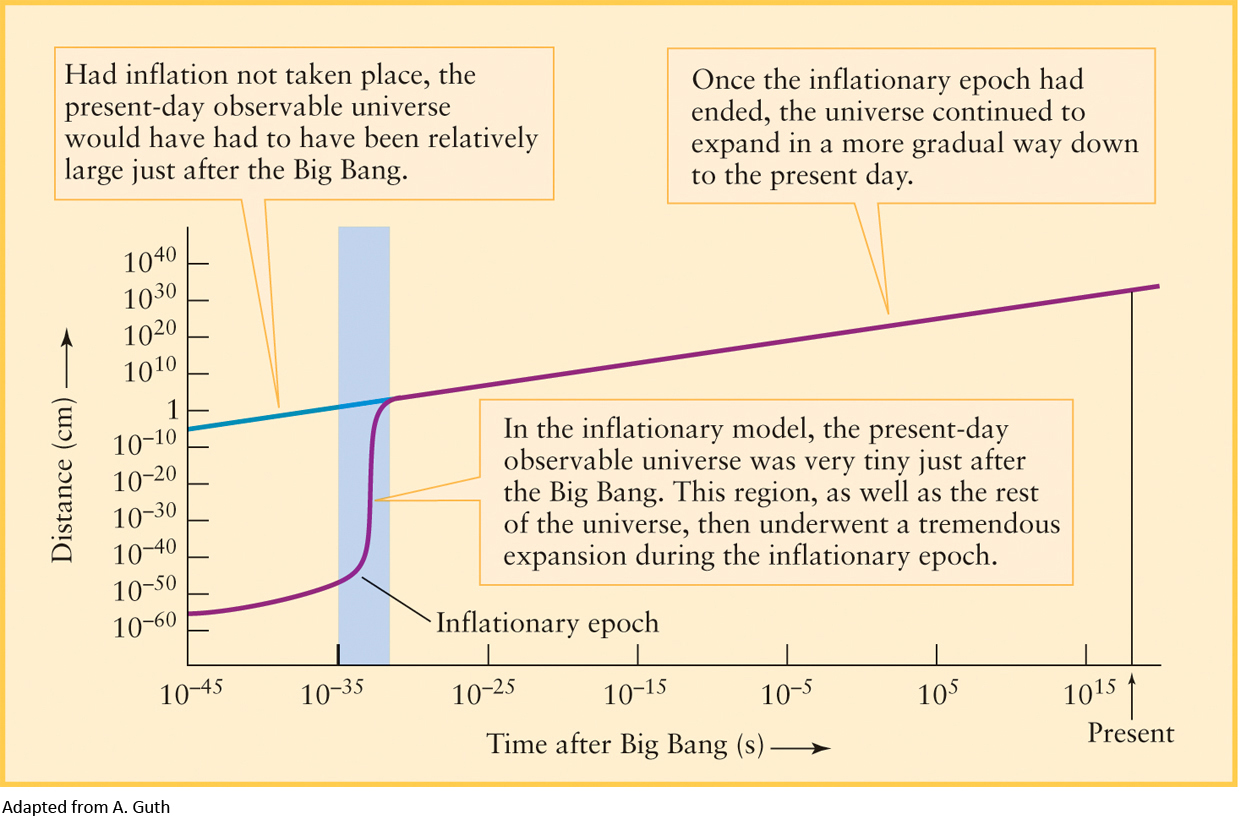
372
Inflation accounts for the isotropy of the microwave background. During the inflationary epoch, much of the material that was originally near our location was moved out to tremendous distances. Over the past 13.7 billion years, our view has expanded so that we can see radiation from these distant regions. Hence, when we examine microwaves from opposite parts of the sky, we are seeing radiation from parts of the universe that were originally in intimate contact with one another. This common origin is why all parts of the sky have almost exactly the same temperature.
Question
ConceptCheck 15-11: Is the universe expanding today at the same rate it did right after the Big Bang?
The Fundamental Forces of Nature
If the universe went through an episode of extreme inflation, what could have triggered it? Our understanding is that inflation was one of a sequence of remarkable events during the first 10−12 second after the Big Bang. In each of these events there was a fundamental transformation of the basic physical properties of the universe. To understand what happened during that brief moment of time, when the universe was a hot, dense sea of fast-moving particles and energetic photons colliding with each other, we must first understand how particles interact at very high energies.
Just four fundamental forces—gravitation, electromagnetism, and the strong and weak forces—explain the interactions of everything in the universe. Of these forces, gravitation is the most familiar (Figure 15-15a). It is a long-range force that dominates the universe over astronomical distances. The electromagnetic force is also a long-range force, but it is intrinsically much stronger than the gravitational force. For example, the electromagnetic force between an electron and a proton is about 1039 times stronger than the gravitational force between those two particles. That is why the electromagnetic force, not the gravitational force, is responsible for holding electrons in orbit about the nuclei in atoms.
We do not generally observe longer-range effects of the electromagnetic force, because there is usually a negative electric charge for every positive charge and a south magnetic pole for every north magnetic pole. Thus, over great volumes of space the effects of electromagnetism effectively cancel out. No similar canceling occurs with gravity because there is no equivalent “negative mass.” This explains why the force that holds Earth in orbit around the Sun is gravitational, not electromagnetic.
The strong force holds protons and neutrons together inside the nuclei of atoms (Figure 15-15b). It is said to be a short-range force: Its influence extends only over distances less than the diameter of a proton, about 10−15 m. Without the strong force, nuclei would disintegrate because of the electromagnetic repulsion of the positively charged protons. In fact, the strong force overpowers the electromagnetic forces inside nuclei.
The weak force, which also is a short-range force, is at work in certain kinds of radioactive decay (Figure 15-15c). An example is the transformation of a neutron (n) into a proton (p), in which an electron (e−) is released along with a nearly massless particle called an antineutrino ( ).
).
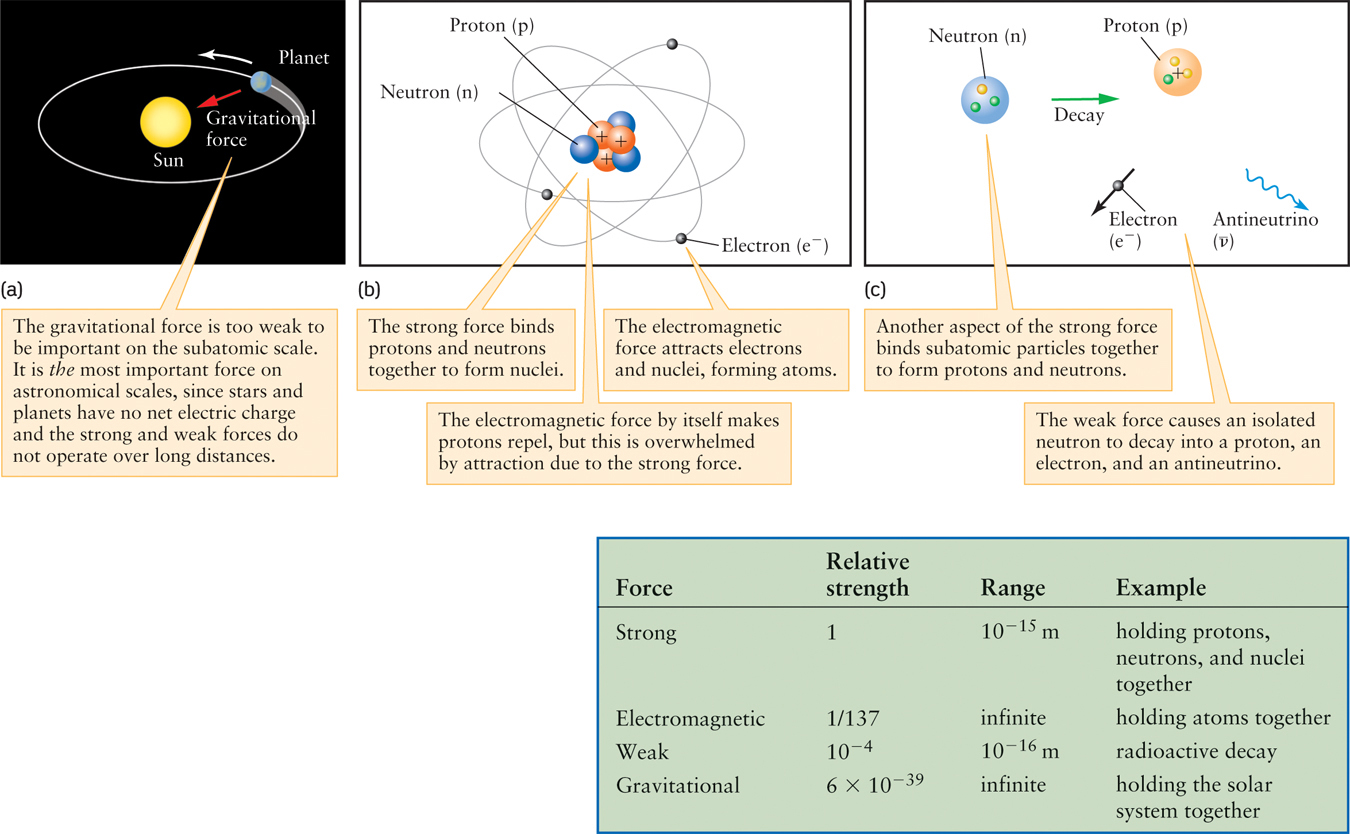
In the 1970s, Sheldon Glashow, Howard Georgi, Jogesh Pati, and Abdus Salam proposed grand unified theories (or GUTs), which predict that the strong force becomes unified with the weak and electromagnetic forces at high energies and temperature. In other words, in special situations like the early universe, the strong, weak, and electromagnetic interactions would all be long-range forces and would be indistinguishable from each other.
373
Many physicists suspect that all four forces may be unified at tremendously high energies (Figure 15-16). That is, if particles were to collide at these colossal energies, such as occurred in the very young universe during the Big Bang, there would be no difference between the gravitational, electromagnetic, and nuclear forces. However, no one has yet succeeded in working out the details of such a supergrand unified theory, which is sometimes called a theory of everything (or TOE).
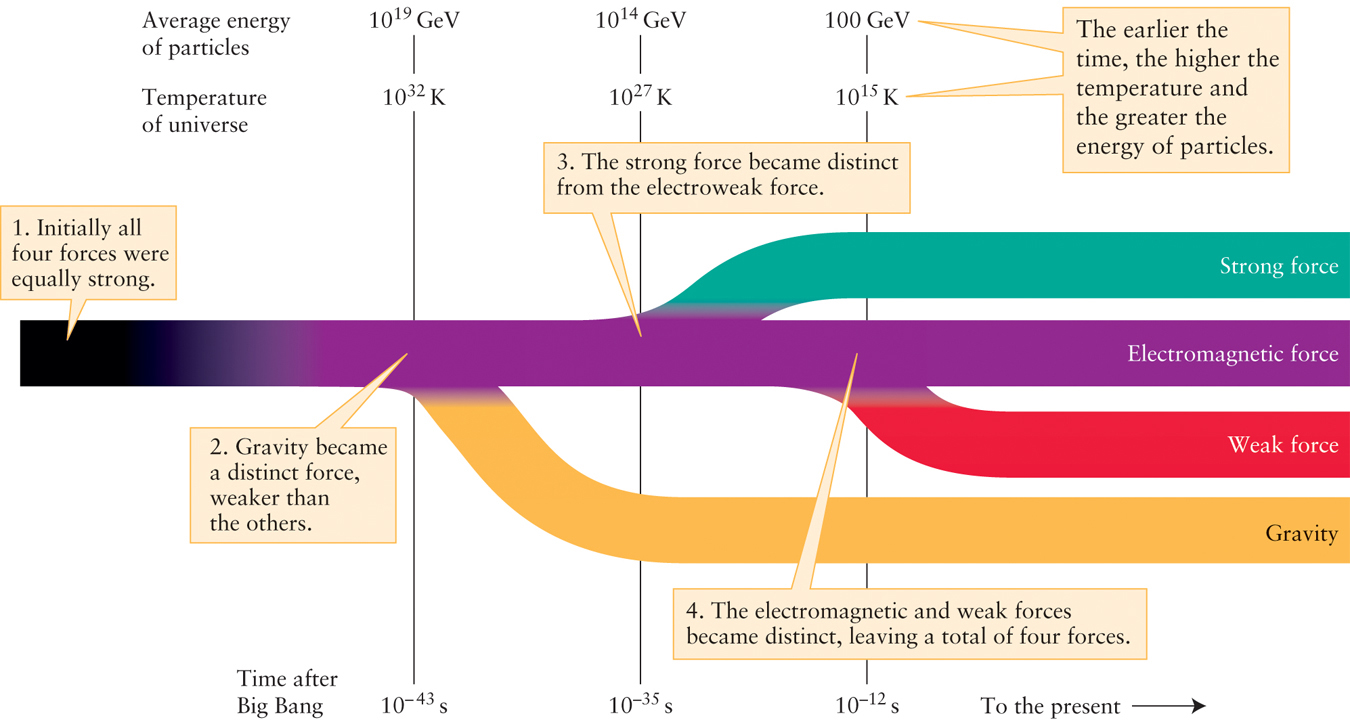
Question
ConceptCheck 15-12: Which of the four fundamental forces is the most influential between two protons?
374